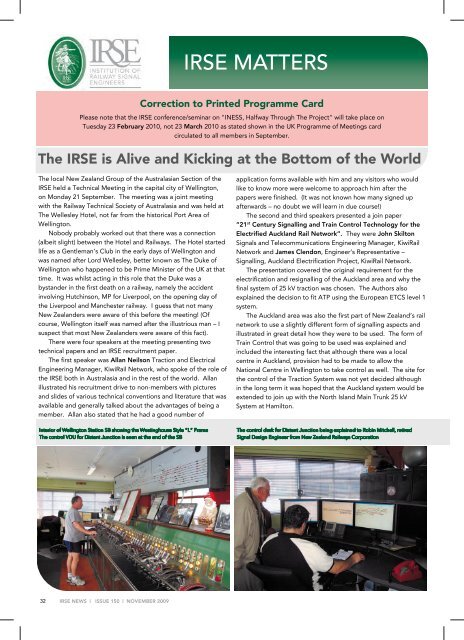IRSE News 150 Nov 09.pdf
IRSE News 150 Nov 09.pdf
IRSE News 150 Nov 09.pdf
Create successful ePaper yourself
Turn your PDF publications into a flip-book with our unique Google optimized e-Paper software.
<strong>IRSE</strong> MATTERS<br />
Correction to Printed Programme Card<br />
Please note that the <strong>IRSE</strong> conference/seminar on "INESS, Halfway Through The Project" will take place on<br />
Tuesday 23 February 2010, not 23 March 2010 as stated shown in the UK Programme of Meetings card<br />
circulated to all members in September.<br />
The <strong>IRSE</strong> is Alive and Kicking at the Bottom of the World<br />
The local New Zealand Group of the Australasian Section of the<br />
<strong>IRSE</strong> held a Technical Meeting in the capital city of Wellington,<br />
on Monday 21 September. The meeting was a joint meeting<br />
with the Railway Technical Society of Australasia and was held at<br />
The Wellesley Hotel, not far from the historical Port Area of<br />
Wellington.<br />
Nobody probably worked out that there was a connection<br />
(albeit slight) between the Hotel and Railways. The Hotel started<br />
life as a Gentleman’s Club in the early days of Wellington and<br />
was named after Lord Wellesley, better known as The Duke of<br />
Wellington who happened to be Prime Minister of the UK at that<br />
time. It was whilst acting in this role that the Duke was a<br />
bystander in the first death on a railway, namely the accident<br />
involving Hutchinson, MP for Liverpool, on the opening day of<br />
the Liverpool and Manchester railway. I guess that not many<br />
New Zealanders were aware of this before the meeting! (Of<br />
course, Wellington itself was named after the illustrious man – I<br />
suspect that most New Zealanders were aware of this fact).<br />
There were four speakers at the meeting presenting two<br />
technical papers and an <strong>IRSE</strong> recruitment paper.<br />
The first speaker was Allan Neilson Traction and Electrical<br />
Engineering Manager, KiwiRail Network, who spoke of the role of<br />
the <strong>IRSE</strong> both in Australasia and in the rest of the world. Allan<br />
illustrated his recruitment drive to non-members with pictures<br />
and slides of various technical conventions and literature that was<br />
available and generally talked about the advantages of being a<br />
member. Allan also stated that he had a good number of<br />
application forms available with him and any visitors who would<br />
like to know more were welcome to approach him after the<br />
papers were finished. (It was not known how many signed up<br />
afterwards – no doubt we will learn in due course!)<br />
The second and third speakers presented a join paper<br />
“21 st Century Signalling and Train Control Technology for the<br />
Electrified Auckland Rail Network”. They were John Skilton<br />
Signals and Telecommunications Engineering Manager, KiwiRail<br />
Network and James Clendon, Engineer’s Representative –<br />
Signalling, Auckland Electrification Project, KiwiRail Network.<br />
The presentation covered the original requirement for the<br />
electrification and resignalling of the Auckland area and why the<br />
final system of 25 kV traction was chosen. The Authors also<br />
explained the decision to fit ATP using the European ETCS level 1<br />
system.<br />
The Auckland area was also the first part of New Zealand’s rail<br />
network to use a slightly different form of signalling aspects and<br />
illustrated in great detail how they were to be used. The form of<br />
Train Control that was going to be used was explained and<br />
included the interesting fact that although there was a local<br />
centre in Auckland, provision had to be made to allow the<br />
National Centre in Wellington to take control as well. The site for<br />
the control of the Traction System was not yet decided although<br />
in the long term it was hoped that the Auckland system would be<br />
extended to join up with the North Island Main Trunk 25 kV<br />
System at Hamilton.<br />
Interior of Wellington Station SB showing the Westinghouse Style “L” Frame<br />
The control VDU for Distant Junction is seen at the end of the SB<br />
The control desk for Distant Junction being explained to Robin Mitchell, retired<br />
Signal Design Engineer from New Zealand Railways Corporation<br />
32<br />
<strong>IRSE</strong> NEWS | ISSUE <strong>150</strong> | NOVEMBER 2009

















